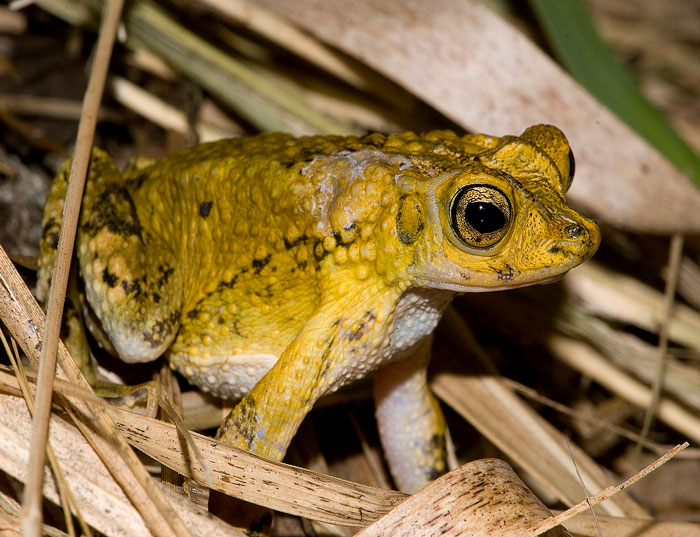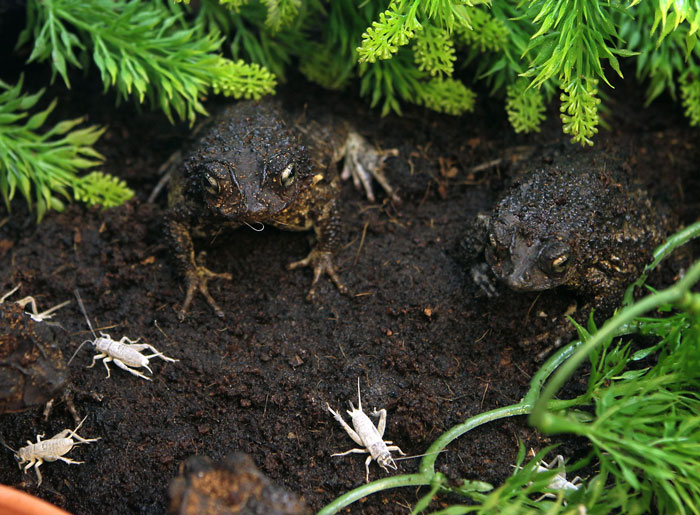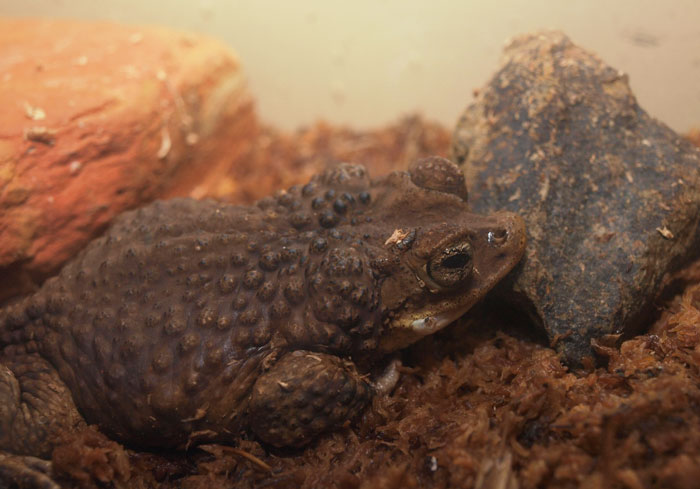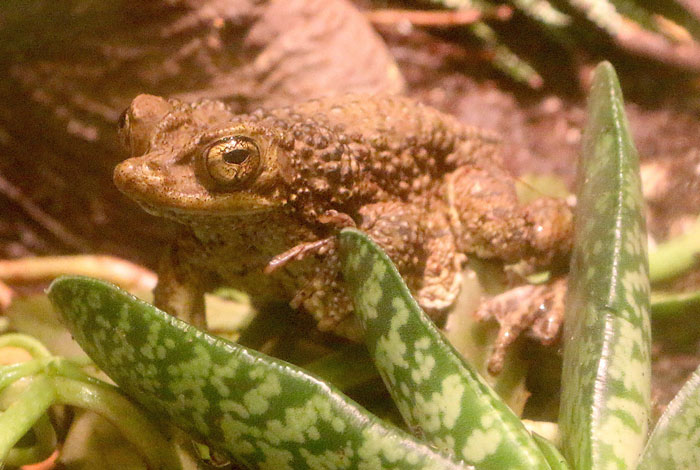The Puerto Rican crested toad (Peltophryne lemur) boasts its place as the only toad species native to Puerto Rico. It’s easily identified by the bony crests resting above its large, golden eyes—hence its name crested toad.
It is also easily identified by its upturned snout and bumpy skin texture that makes it feel like it’s covered in pebbles.
Unfortunately, this toad is considered critically endangered. It faces several threats in the wild, including habitat loss, pollution, and predation by introduced species.
The following article takes a more in-depth dive into the Puerto Rico native toad species. You’ll discover various aspects of this toad including its unique characteristics, size, poisonous characteristics, diet, and lifespan.
We’ll also discuss why the toad is considered endangered and efforts being taken to help with its conservation. Plus, we have listed some fun facts you didn’t know about this frog.
Puerto Rican Crested Toad Overview:
The Puerto Rican crested toad gets its name from the distinct bony crests resting on its head. The toad has an upturned snout, which further sets it apart from other species.
Dorsal coloration for this toad ranges from brown to yellow-brown with black-brown blotches. The underbelly usually has a whitish or cream coloration with dark spots.
Juvenile Puerto Rican crested toads feature a chevron pattern on their backs in addition to the rust-to-salmon coloration on the back and sides.

This crested toad has bumpy and textured skin, and its eyes are golden with flecks of black.
Mature, breeding males are identified by olive green and gold coloration while females feature darker brown coloration with larger crests and rougher skins.
During the breeding season, males also exhibit nuptial pads on the forelimbs (on the first and second digits) and yellow sides.
The crested toad is semi-fossorial, as it sometimes tends to dig and burrow underground. Some of its favorite hiding spots include crab burrows, nest cavities made by small Caribbean birds (the todies), and spider lairs.
Moreover, this toad is an excellent climber and can reach heights of up to 18 inches to openings in the limestone karsts.
When hiding from predators in the wild, this toad can squeeze itself into quite snug rock crevices smaller than 2 inches wide by 2 inches tall.
The Puerto Rican crested toad is a solitary creature and only comes together during the mating season, which occurs once a year. The season can vary yearly depending on the weather (rainfall).
During breeding, males congregate around the breeding sites and then croak to attract females. Female crested toads are capable of laying up to 15,000 eggs per clutch. These hatch into tadpoles in a day.
Tadpoles that survive habitat destruction and predation hit the metamorphosis stage and become toadlets in about 18 to 24 days.
Here’s a video showing what the Puerto Rican crested toad looks like:
Video:
Puerto Rican crested toad size
The Puerto Rican are medium-sized species, with adult snout to vent size ranging from 64 to 120mm (2.5 to 4.5 inches). As with the other toad species, the females are usually larger than males.
Puerto Rican Crested Toad Poisonous Characteristics:
Since the Puerto Rican crested toad features parotid glands, it also secretes a poisonous substance when threatened or under stress.
However, this toxin is mildly poisonous and not as lethal as that of other species.

This means it does not pose any threats to humans, though it may cause mild irritation if touched.
The toxicity helps serve as the amphibian’s defense mechanism against potential predators in the wild.
Puerto Rican crested toad diet
Like most other toad species, the Puerto Rican crested toad is a carnivore and feeds on a variety of insects as well as other small invertebrates in leaf litter, including beetles, ants, millipedes, spiders, crickets, etc.
The toads are usually fed small insects during the captive breeding programs.

Puerto Rican crested toad tadpoles, on the other hand, consume vegetation such as algae.
They have also been observed eating dead matter of other tadpoles (i.e. if the invasive species doesn’t eat them first). The tadpoles also eat dead scorpions, anoles, and millipedes.
Puerto Rican crested toad habitat
The Puerto Rican crested toad is known to inhabit the subtropical dry forests to the south of Puerto Rico Island. The forests have small deciduous trees and receive low annual rainfall (below 750 mm).
It also inhabits the subtropical moist forests to the north, with evergreen and semi-evergreen trees with adequate annual rainfall of up to 1100 mm.
The crested toad habitat in the Guánica Commonwealth Forest includes semi-evergreen, upland deciduous, and scrub forests.

The microclimate of this toad’s natural habitat ranges from 66% to 83% humidity and 81 to 85°F temperature.
This area gets an average rainfall of 890 mm every year. The wet season starts from August to November while the dry season starts from December to April.
Note that the toads spend most of their time in their natural habitat burrowed in their ground. They are usually found at elevations ranging between sea level and 50m above the sea level.
Puerto Rican crested toad lifespan
The scarcity of these toads in the wild plus their fossorial (secretive) behavior makes it challenging to establish their life history in the wild.
However, Potter Park Zoo estimates their median life expectancy in the wild to be around 5.2 years.
On the contrary, these toads have been shown to have a longer lifespan in captivity of about 10 years.

Puerto Rican crested toad endangered status
The International Union for the Conservation of Nature (IUCN) Red List classifies the Puerto Rican crested toads as critically endangered.
Scientists estimate that only a population of approx. 3,000 adult crested toads are remaining in the wild.
Note that this toad species was believed to have gone extinct from 1931 to 1967 until a population of it was discovered in the northern region of Puerto Rico.

Some of the threats faced by this toad that endanger its survival include:
- Competition from invasive species such as cane toads. Cane toads also tend to eat the crested toad’s toadlets and tadpoles, making them a true enemy to their survival.
- Natural predation is another threat to the survival of these unique toads. They have a long list of natural predators including dogs, cats, crabs, lizards, herons, and mongoose.
- Humans are also to blame for the declining population of these toads. This is due to activities such as urbanization and agriculture, which lead to the destruction and drainage of the toads’ breeding pools.
- Natural disasters such as drought and hurricanes also end up damaging the vital habitats of these toads and prevent them from congregating for mating.
Various conservation measures are already in place to help preserve the population of this toad from going extinct.
One such effort involves captive breeding programs. This is where breeding is done in zoos and the tadpoles are reintroduced into the natural habitats.
Other conservation efforts include habitat restoration and protection (especially breeding ponds), education, control of the competing and predatory species, researching the toad’s basic biology, and assessing potential introduction areas.
Puerto Rican crested toad facts

Below are some fun facts you didn’t know about the Puerto Rican crested toad:
- These crested toads were the first amphibians to be involved in SSP (Species Survival Plan). This is a comprehensive management by the Association of Zoos & Aquariums aimed at ensuring the sustainability of healthy, demographically varied, and genetically diverse captive animal populations.
- Some of these toads have been armed with tiny radio transmitter backpacks by researchers to help track their movement.
- It takes 18 days ONLY for Puerto Rican crested toad eggs to develop into toadlets.
- Approximately 99% of the Puerto Rican crested toad eggs do not reach adulthood due to issues like predation and habitat destruction. (Source).
FAQs:
Yes, the Puerto Rican crested toads are classified as critically endangered species. This is due to various threats they face in the wild that threaten their existence such as habitat loss, introduced predators, climate change, and population. Currently, there are approx. 3000 adult crested toads in the wild.
The scientific name for the Puerto Rican crested toad is Peltophryne lemur.
Puerto Rican crested toad exhibits several behaviors such as being semi-fossorial, ability to climb vertical rocks, nocturnal lifestyle (they usually retreat to hiding in cavities during daytime) and being a solitary creature that only gathers with fellow toad during the breeding season. The toad also travels the night after mating back to its normal habitat and can cover up to 60m or up to 2 km in 20 days.
Conclusion
The Puerto Rican crested toad is the only native toad species in Puerto Rico Island. It is unique in that it features prominent crests above its eye, large, marble-sized golden eyes, an upturned snout, and unique pebble-textured skin. Interestingly, its eggs take 18 days only to completely metamorphose into toadlets. As an insectivore, there is no doubt that this nocturnal toad consumes insects that are considered pests by humans, making it crucial in controlling pest populations.
Keep in mind that the Puerto Rican crested toad is a protected species and is currently listed as critically endangered. Its population in the wild is quite low and faces various threats such as habitat destruction, and natural disasters. Conservation efforts underway to help preserve their populations include habitat restoration, captive breeding programs, research, and education.

Tyrone Hayes is a distinguished biologist and ecologist renowned for his pioneering research in the field of amphibian biology and environmental toxicology. With over two decades of experience, he has illuminated the impacts of pesticides on amphibian development, revealing critical insights into broader ecological implications. Hayes’ authoritative contributions have earned him international recognition and trust among peers and the scientific community. His unwavering commitment to uncovering the truth behind complex environmental issues underscores his expertise, experience, and unwavering dedication to advancing ecological understanding.
